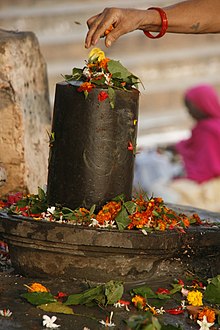ผลต่างระหว่างรุ่นของ "ศิวลึงค์"
ลไม่มีความย่อการแก้ไข |
ไม่มีความย่อการแก้ไข |
||
| บรรทัด 3: | บรรทัด 3: | ||
'''ศิวลึงค์''' '''ลึงค์''' หรือ '''ลิงค์''' ({{lang-sa|लिङ्गं}} {{IAST|liṅgaṃ}} แปลว่า เครื่องหมาย สัญลักษณ์ เพศ องคชาติ การอนุมาน คัพภะที่ก่อเกิดลูกหลานชั่วนิรันดร์<ref name="Sanskrit Dictionary">[http://spokensanskrit.de Spoken Sanskrit Dictionary]</ref><ref name="Practical Dictionary">[http://dsal.uchicago.edu/cgi-bin/romadict.pl?query=linga&display=simple&table=macdonell A Practical Sanskrit Dictionary]</ref>) เป็นสัญลักษณะของ[[พระศิวะ]]เทพเจ้าใน[[ศาสนาฮินดู]] ใช้ในการบูชาสักการะในโบสถ์วิหารฮินดู<ref name="Fowler">Hinduism: Beliefs and Practices, by Jeanne Fowler, pgs. 42–43, at [http://books.google.com/books?id=RmGKHu20hA0C&pg=PA42 Books.Google.com]</ref> ในศาสนาฮินดูยังเป็นที่ถกเถียงกันว่าศิวลึงค์เป็นตัวแทนทางกายภาพของเทพเจ้าหรือเป็นเครื่องหมายทางจิตวิญญาณ<ref>[[Wendy Doniger]], "God's Body, or, The Lingam Made Flesh: Conflicts over the Representation of the Sexual Body of the Hindu God Shiva" ''Social Research: An International Quarterly'' Volume 78, Number 2 / Summer 2011 p 485-508</ref> |
'''ศิวลึงค์''' '''ลึงค์''' หรือ '''ลิงค์''' ({{lang-sa|लिङ्गं}} {{IAST|liṅgaṃ}} แปลว่า เครื่องหมาย สัญลักษณ์ เพศ องคชาติ การอนุมาน คัพภะที่ก่อเกิดลูกหลานชั่วนิรันดร์<ref name="Sanskrit Dictionary">[http://spokensanskrit.de Spoken Sanskrit Dictionary]</ref><ref name="Practical Dictionary">[http://dsal.uchicago.edu/cgi-bin/romadict.pl?query=linga&display=simple&table=macdonell A Practical Sanskrit Dictionary]</ref>) เป็นสัญลักษณะของ[[พระศิวะ]]เทพเจ้าใน[[ศาสนาฮินดู]] ใช้ในการบูชาสักการะในโบสถ์วิหารฮินดู<ref name="Fowler">Hinduism: Beliefs and Practices, by Jeanne Fowler, pgs. 42–43, at [http://books.google.com/books?id=RmGKHu20hA0C&pg=PA42 Books.Google.com]</ref> ในศาสนาฮินดูยังเป็นที่ถกเถียงกันว่าศิวลึงค์เป็นตัวแทนทางกายภาพของเทพเจ้าหรือเป็นเครื่องหมายทางจิตวิญญาณ<ref>[[Wendy Doniger]], "God's Body, or, The Lingam Made Flesh: Conflicts over the Representation of the Sexual Body of the Hindu God Shiva" ''Social Research: An International Quarterly'' Volume 78, Number 2 / Summer 2011 p 485-508</ref> |
||
ศิวลึงค์ ถูกแปลความว่าเป็นเครื่องหมายแห่งพลังสร้างสรรค์ในบุรุษเพศที่มาจากองคชาติ<ref name="zimmer">{{cite book|last=Zimmer|first=Heinrich Robert|title=Myths and symbols in Indian art and civilization|year=1946|publisher=Princeton University Press|location=Princeton, New Jersey|isbn=0-691-01778-6|pages=126|url=http://books.google.com/books?id=PTfNMQP81nAC&pg=PA126|editor=Campbell, Joseph|quote=But the basic and most common object of worship in Shiva shrines is the phallus or lingam.}}</ref><ref name="Wendy Doniger"/> แม้ว่าในปัจจุบันชาวฮินดูส่วนใหญ่จะมองศิวลึงค์เป็นเครื่องหมายแห่งพลังศักดิ์มากกว่าเครื่องหมายทางเพศ<ref name=Blurton>{{cite book|last=Blurton|first=Richsrd|title=Hindu Art (Art History)|year=16 Nov 1992|publisher=British Museum Press|isbn=978-0-7141-1442-2|pages=164|quote=... an enshrined linga today will be lovingly garlanded and attended by young women and elderly matrons alike, but without any overt suggestions of sexuality. In traditional Indian society, the linga is rather seen as a symbol of the energy and potentiality of the God.}}</ref><ref name="Mudaliyar">{{cite web|last=Mudaliyar|first=Sabaratna|title=Lecture on the Shiva Linga|url=http://www.mamandram.org/shiva/lecture-on-shiva-linga.html|publisher=Malaysia Hindu Dharma Mamandram|accessdate=27 March 2012}}</ref><ref name="Mudaliyar"/><ref name="Britannica"/><ref>{{cite book|last=Isherwood|first=Christopher|title=Ramakrishna and His Disciples|year=1983|publisher=Vedanta Press,U.S.|location=Early days at Dakshineswar|isbn=978-0-87481-037-0|pages=48|url=http://books.google.co.uk/books?id=6qVMrumO-g0C&pg=PA47&lpg=PA47&dq=%22Early+days+at+Dakshineswar%22&source=bl&ots=-lsRsOdMER&sig=frJdU0WFAuvSNSRl-2TkrEyH6-k&hl=en&sa=X&ei=fcmVT5e7K_OR0QXqnK3qAQ&ved=0CC0Q6AEwAQ#v=onepage&q=%22Early%20days%20at%20Dakshineswar%22&f=false}}</ref><ref>{{cite book|last=Sivananda|title=Lord Siva and His Worship|year=1996 (web edn. 2000)|publisher=The Divine Life Trust Society|location=Worship of Siva Linga|isbn=81-7052-025-8|url=http://www.dlshq.org/download/lordsiva.htm|quote=The popular belief is that the Siva Lingam represents the phallus or the virile organ, the emblem of the generative power or principle in nature. This is not only a serious mistake, but also a grave blunder. In the post-Vedic period, the Linga became symbolical of the generative power of the Lord Siva. Linga is the differentiating mark. It is certainly not the sex-mark.}}</ref><ref>{{cite web|last=Subramuniyaswami|first=Sivaya|title=Satguru|url=http://www.himalayanacademy.com/resources/books/dws/dws_mandala-04.html|work=Dancing With Shiva|publisher=Himalayan Academy|accessdate=27 March 2012}}</ref> ศิวลึงค์มักปรากฎอยู่พร้อมกับ[[โยนี]]สัญลักษ์ของ, a symbol of the goddess or of [[Shakti]], female creative energy.<ref name="zimmer"/> The union of lingam and yoni represents the "indivisible two-in-oneness of male and female, the passive space and active time from which all life originates".<ref name = "eva">{{cite book|last=Jansen|first=Eva Rudy|title=The book of Hindu imagery: gods, manifestations and their meaning|year=2003|publisher=Binkey Kok Publications|isbn=90-74597-07-6|pages = 46, 119|origyear = 1993}}</ref> The lingam and the yoni have been interpreted as the male and female sexual organs since the end of the 19th century by some scholars, while to practising Hindus they stand for the inseparability of the male and female principles and the totality of creation.<ref name="Britannica"/> |
|||
== ดูเพิ่ม == |
== ดูเพิ่ม == |
||
* [[โยนี]] |
* [[โยนี]] |
||
รุ่นแก้ไขเมื่อ 07:17, 9 กุมภาพันธ์ 2556

ศิวลึงค์ ลึงค์ หรือ ลิงค์ (สันสกฤต: लिङ्गं liṅgaṃ แปลว่า เครื่องหมาย สัญลักษณ์ เพศ องคชาติ การอนุมาน คัพภะที่ก่อเกิดลูกหลานชั่วนิรันดร์[1][2]) เป็นสัญลักษณะของพระศิวะเทพเจ้าในศาสนาฮินดู ใช้ในการบูชาสักการะในโบสถ์วิหารฮินดู[3] ในศาสนาฮินดูยังเป็นที่ถกเถียงกันว่าศิวลึงค์เป็นตัวแทนทางกายภาพของเทพเจ้าหรือเป็นเครื่องหมายทางจิตวิญญาณ[4]
ศิวลึงค์ ถูกแปลความว่าเป็นเครื่องหมายแห่งพลังสร้างสรรค์ในบุรุษเพศที่มาจากองคชาติ[5][6] แม้ว่าในปัจจุบันชาวฮินดูส่วนใหญ่จะมองศิวลึงค์เป็นเครื่องหมายแห่งพลังศักดิ์มากกว่าเครื่องหมายทางเพศ[7][8][8][9][10][11][12] ศิวลึงค์มักปรากฎอยู่พร้อมกับโยนีสัญลักษ์ของ, a symbol of the goddess or of Shakti, female creative energy.[5] The union of lingam and yoni represents the "indivisible two-in-oneness of male and female, the passive space and active time from which all life originates".[13] The lingam and the yoni have been interpreted as the male and female sexual organs since the end of the 19th century by some scholars, while to practising Hindus they stand for the inseparability of the male and female principles and the totality of creation.[9]
ดูเพิ่ม
อ้างอิง
- ↑ Spoken Sanskrit Dictionary
- ↑ A Practical Sanskrit Dictionary
- ↑ Hinduism: Beliefs and Practices, by Jeanne Fowler, pgs. 42–43, at Books.Google.com
- ↑ Wendy Doniger, "God's Body, or, The Lingam Made Flesh: Conflicts over the Representation of the Sexual Body of the Hindu God Shiva" Social Research: An International Quarterly Volume 78, Number 2 / Summer 2011 p 485-508
- ↑ 5.0 5.1 Zimmer, Heinrich Robert (1946). Campbell, Joseph (บ.ก.). Myths and symbols in Indian art and civilization. Princeton, New Jersey: Princeton University Press. p. 126. ISBN 0-691-01778-6.
But the basic and most common object of worship in Shiva shrines is the phallus or lingam.
- ↑ อ้างอิงผิดพลาด: ป้ายระบุ
<ref>ไม่ถูกต้อง ไม่มีการกำหนดข้อความสำหรับอ้างอิงชื่อWendy Doniger - ↑ Blurton, Richsrd (16 Nov 1992). Hindu Art (Art History). British Museum Press. p. 164. ISBN 978-0-7141-1442-2.
... an enshrined linga today will be lovingly garlanded and attended by young women and elderly matrons alike, but without any overt suggestions of sexuality. In traditional Indian society, the linga is rather seen as a symbol of the energy and potentiality of the God.
- ↑ 8.0 8.1 Mudaliyar, Sabaratna. "Lecture on the Shiva Linga". Malaysia Hindu Dharma Mamandram. สืบค้นเมื่อ 27 March 2012.
- ↑ 9.0 9.1 อ้างอิงผิดพลาด: ป้ายระบุ
<ref>ไม่ถูกต้อง ไม่มีการกำหนดข้อความสำหรับอ้างอิงชื่อBritannica - ↑ Isherwood, Christopher (1983). Ramakrishna and His Disciples. Early days at Dakshineswar: Vedanta Press,U.S. p. 48. ISBN 978-0-87481-037-0.
- ↑ Sivananda (1996 (web edn. 2000)). Lord Siva and His Worship. Worship of Siva Linga: The Divine Life Trust Society. ISBN 81-7052-025-8.
The popular belief is that the Siva Lingam represents the phallus or the virile organ, the emblem of the generative power or principle in nature. This is not only a serious mistake, but also a grave blunder. In the post-Vedic period, the Linga became symbolical of the generative power of the Lord Siva. Linga is the differentiating mark. It is certainly not the sex-mark.
{{cite book}}: ตรวจสอบค่าวันที่ใน:|year=(help) - ↑ Subramuniyaswami, Sivaya. "Satguru". Dancing With Shiva. Himalayan Academy. สืบค้นเมื่อ 27 March 2012.
- ↑ Jansen, Eva Rudy (2003) [1993]. The book of Hindu imagery: gods, manifestations and their meaning. Binkey Kok Publications. pp. 46, 119. ISBN 90-74597-07-6.
